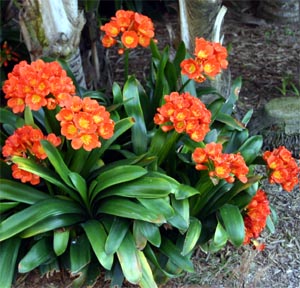
Clivia, also called bush lily, is an elegant flowering plant and a good alternative to other winter-blooming plants such as azaleas, amaryllis or holiday cactus. The orange or yellow, long-lasting flowers are produced in dense clusters of 12 to 20 flowers on top of a thick stem that pushes up from between a fan of evergreen, strap-like leaves.
This member of the amaryllis family shares many common characteristics with the more familiar amaryllis. Flowers are similar in shape, but Clivia flowers are much smaller than the trumpet-shaped amaryllis flowers. While each individual flower lasts only a few days, buds continue to open in succession for a floral display of several weeks.
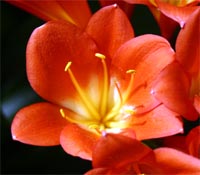
Like the amaryllis, the long, strap-like leaves arise from a bulb-like base, directly opposite one another in an alternating sequence. As the leaves arch over one another, the mature plant has a symmetrical, formal silhouette and can be 2 to 3 feet tall and almost as wide. Like many other amaryllids, Clivia is considered poisonous because it contains small amounts of the alkaloid lycorine. However, large quantities must be ingested to cause symptoms of toxicity.

This small genus, native to forests and bush lands of the subtropical regions of southern Africa, was first collected near the mouth of the Great Fish River in the Eastern Cape in September 1815 by English naturalist William J. Burchell. The genus was named in 1828 by Kew botanist John Lindley after Lady Charlotte Florentine Clive, Duchess of Northumberland, who first cultivated and flowered the type specimen in England. Clivia nobilis, a pendulous-flowered type, from coastal areas of the Eastern Cape Province, was the first species described. The showier, trumpet-flowered C. miniata was discovered in KwaZulu-Natal in the early 1850s and quickly became a very popular indoor plant during the Victorian era – and is still the most common Clivia grown in the US. It is found from KwaZulu-Natal Province and the eastern Transvaal to Swaziland.
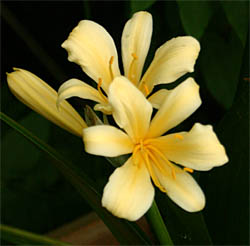
A yellow form of C. miniata citrina was collected about 1888 in Zululand. Other pendulous-flowered species described later include C. gardenii from KwaZulu-Natal and the Eastern Cape Provinces; C. robusta, long confused with C. gardenii because the flowers are similar, but this species grows in streams and wet areas; and C. caulescens from the eastern parts of Mpumalanga and Northern Province. A fifth species, C. mirabilis, was discovered in 2002 from Namaqualand in the Northern Cape winter rainfall area.
This tough plant survives in both dry and moist soil and bright indirect light or deep shade, making it well suited to growing as a houseplant (it is hardy only in zones 9 and 10 in the US, where huge clumps are often seen in shaded areas of parks, gardens and residential plantings). It is quite drought tolerant because of its thick, fleshy roots that store water. In pots, masses of roots often become so large that the plant and growing medium is forced up and out of the pot. Clivia does best when slightly root constricted, so wait until the roots are really crowded before moving the plant to a larger container. They can be divided and repotted at any time of the year. Pull or cut the large fans of leaves apart, making sure each group has plenty of roots, and pot up in a well-drained, humus-rich soil (or soilless) mix.
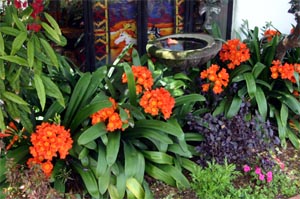
In the wild they are found growing in very organic material, sometimes even on top of rotting logs, usually in deep to partial shade. For best results, grow Clivia in bright diffused light such as a bright north window, or an east or west window shaded from the sun. They can be moved outside for the summer (in the shade or acclimate slowly to brighter conditions so they don’t sunburn), but must be brought in before freezing weather. During the growing season, water regularly but allow the growing medium to become dry to the touch between waterings. They can be fertilized monthly with half-strength fertilizer solution.
Clivias have few pests but mealybugs can be a problem, as they like to hide in the tight spaces between the leaves and may not be noticed until the plant is severely infested. Overwatering and wet conditions will likely lead to root rots.
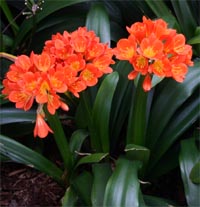
Allowing a rest period for about two months in fall and winter encourages the plants to flower. They need a minimum of a month of cool nighttime temperatures (below 50°F degrees but remaining above freezing; they can tolerate temperatures down to about 36°F), followed by 6-8 weeks with very little water (just enough so the leaves do not wilt) and no fertilization. Once the flower stalk appears, increase watering and return the plant to room temperature. Plants grown in low light rarely flower but still make nice foliage plants. When the flowers fade, remove the stalk at its base, unless you want seeds. If pollinated, the flowers will produce a green, cherry sized berry which slowly turns red over many weeks. The seeds take almost a year to ripen.
Clivia can be propagated by division or from seed. Once a plant is mature (3-4 years), it begins producing one or more offsets each year. These can be separated from the parent plant when they have 3 or 4 leaves. Clivia can be grown from seed but it takes three to five years for them to bloom for the first time and five to 10 years or more (depending on the species or hybrid) to fill a whole container. Fresh seeds should be planted as soon as possible after ripening. Peel off the fleshy pulp, remove the large, pearly seeds, and remove the thin membrane surrounding each seed. Sow in a deep seed-tray, pressing the large seeds gently into the seedling mix until they are flush with the surface. Some growers suggest leaving the micropore (the navel-like growing point where the root will emerge) exposed; others place it on the growing medium. Cover and place in bright indirect light, keeping the medium evenly moist and warm (80º to 85º F). Clivia seeds are slow to germinate; it will take several weeks for the seedlings to develop. If the roots develop out of the ground or push the seed out of the medium too much, make a hole in the medium and carefully re-place the root underground. The seedlings grow slowly and continuously, so begin fertilizing about monthly once the first leaf is well developed. Grow the plants until there are at least 12 mature leaves (2 to 4 years) before trying to induce flowering.
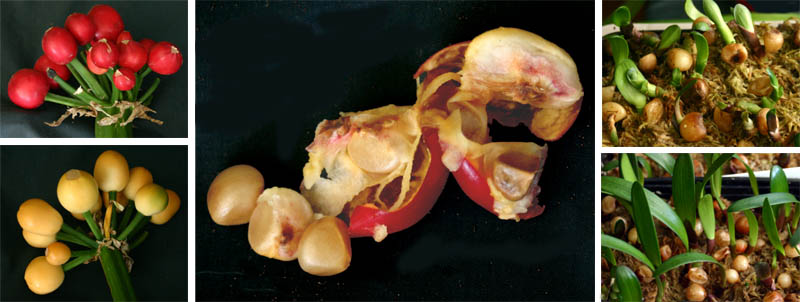
Not surprisingly, horticulturists and breeders were quite interested in C. miniata and shortly after its discovery many hybrids were produced in England, Belgium, Germany and other countries.
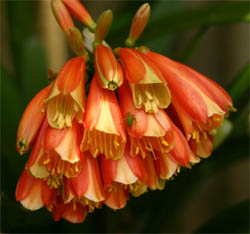
Probably the most well-known hybrid is Clivia x cyrtanthiflora, purportedly a cross of C. miniata and C. nobilis, raised in Ghent, Belgium in the late 1850’s. Breeding and cultivation also took place in South Africa by a few dedicated individuals but today most Clivia breeding has shifted to Japan, China, and Korea, where many selections and interspecific hybrids have been raised. The focus of some breeding is on the foliage – selecting plants for leaf width, veining, and variegation – rather than just the flowers. In addition to the usual orange flowers with yellowish throats, there are forms with scarlet, dark red, peach, pink, and near-white flowers. You may find Clivia at larger nurseries and garden centers but you will probably have to mail order to acquire selected cultivars.
– Susan Mahr, University of Wisconsin – Madison
Ask Your Gardening Question
If you’re unable to find the information you need, please submit your gardening question here:





 Aster, Symphyotrichum spp.
Aster, Symphyotrichum spp. Fascinating Fasciation
Fascinating Fasciation Alternatives to Lawn: Groundcovers
Alternatives to Lawn: Groundcovers Marigolds
Marigolds


